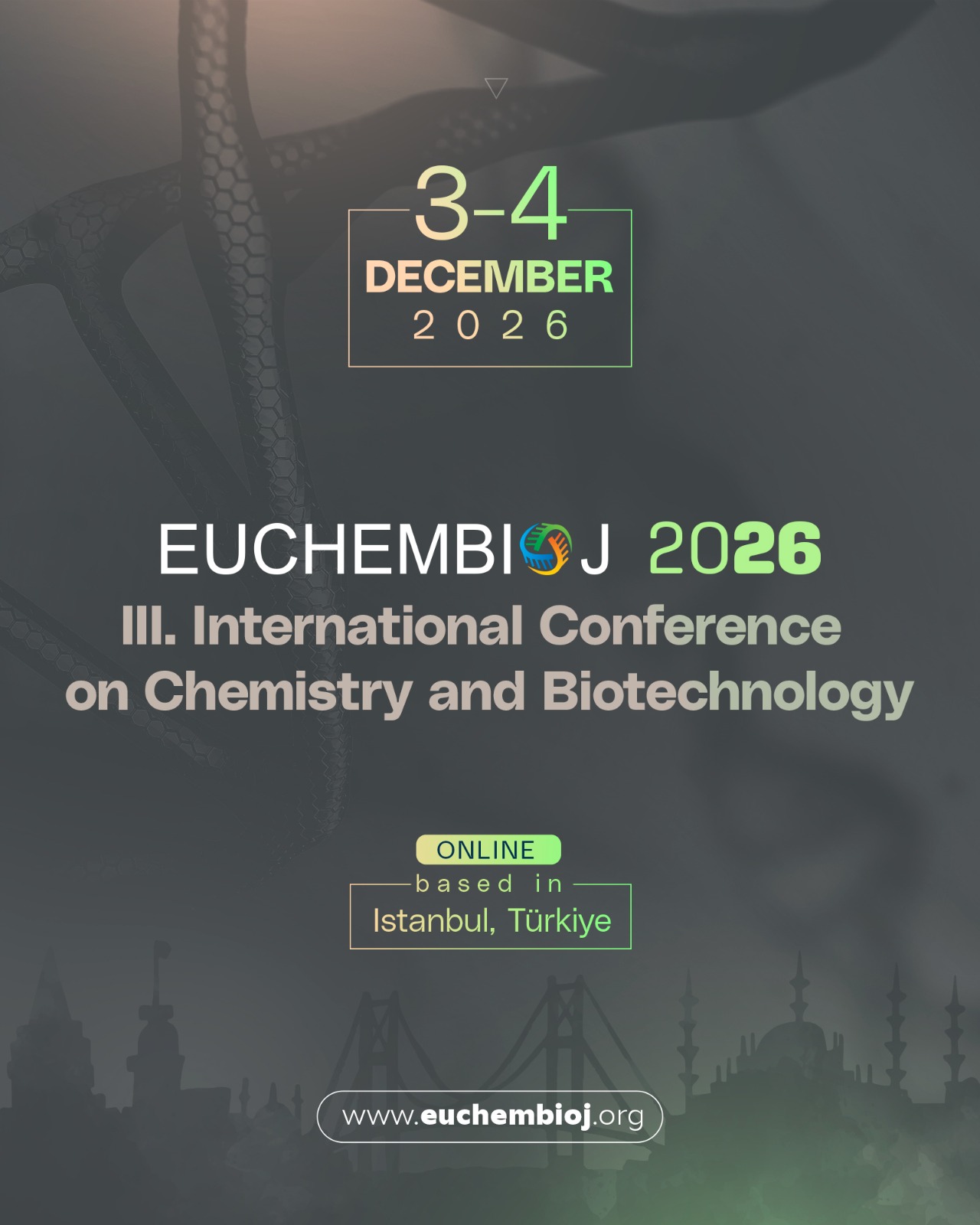Determination of the inhibition effect of hesperetin and its derivatives on Candida glabrata by molecular docking method
DOI:
https://doi.org/10.62063/ecb-15Keywords:
Awp1, Candida glabrata, hesperetin, molecular dockingAbstract
In the study, it was aimed to develop new candidate inhibitor molecules by targeting the AWP1 protein structure of Candida glabrata organism. Hesperetin molecule was taken as a reference and different substituted groups were attached to the determined ends of the molecule to increase the inhibition potential on the protein structure. A total of 100 molecules were designed and after conformer distribution using the Molecular Mechanics/MMFF method for each designed molecule, the area, volume, weight, energy, EHOMO, ELUMO, polarizability, dipole moment, log P values of these molecules were calculated using the Semi Empirical/PM6 method. Molecular docking studies of the optimized molecules were carried out through the Autodock Vina program. After the docking studies, the interactions of the designed molecules with the active site amino acids of the protein structure were analyzed by BIOVIA Discovery Studio Client software in case of possible mutation. As a result of the analysis, five molecules with higher binding energies than other designed molecules and currently used antifungal drugs were recommended.
References
Biovia, D.S.J.S.D.D.S. 2021. Discovery Studio Visualizer v21. 1.0. 20298.
Bongomin, F., Gago, S., Oladele, R.O., & Denning, D.W. (2017). Global and Multi-National Prevalence of Fungal Diseases-Estimate Precision. Journal of fungi (Basel, Switzerland), 3(4), 57. https://doi.org/10.3390/jof3040057 DOI: https://doi.org/10.3390/jof3040057
Calderone, R.A., & Clancy, C.J. (2012). Candida and candidiasis. American Society for Microbiology Press, 2nd Edition. ASM Press, Washington, DC. DOI: https://doi.org/10.1128/9781555817176
De Groot, P.W., Kraneveld, E.A., Yin, Q.Y., Dekker, H.L., Groß, U., Crielaard, W., de Koster, C.G., Bader, O., Klis, F.M., & Weig, M. (2008). The cell wall of the human pathogen Candida glabrata: differential incorporation of novel adhesin-like wall proteins. Eukaryotic cell, 7(11), 1951–1964. https://doi.org/10.1128/EC.00284-08 DOI: https://doi.org/10.1128/EC.00284-08
Duke, J.A. (1992). Database of biologically active phytochemicals & their activity. CRC Press, pp 1-30. ISBN 9780849336713
Eberhardt, J., Santos-Martins, D., Tillack, A.F., & Forli, S. (2021). AutoDock Vina 1.2.0: New Docking Methods, Expanded Force Field, and Python Bindings. Journal of chemical information and modeling, 61(8), 3891-3898. https://doi.org/10.1021/acs.jcim.1c00203 DOI: https://doi.org/10.1021/acs.jcim.1c00203
Enkler, L., Richer, D., Marchand, A.L., Ferrandon, D., & Jossinet, F. (2016). Genome engineering in the yeast pathogen Candida glabrata using the CRISPR-Cas9 system. Scientific reports, 6, 35766. https://doi.org/10.1038/srep35766 DOI: https://doi.org/10.1038/srep35766
Guinea, J. (2014). Global trends in the distribution of Candida species causing candidemia. Clinical microbiology and infection : the official publication of the European Society of Clinical Microbiology and Infectious Diseases, 20 Suppl 6, 5–10. https://doi.org/10.1111/1469-0691.12539 DOI: https://doi.org/10.1111/1469-0691.12539
Gupta, P., Gautam, P., Rai, N., & Kumar, N. (2012). An Emerging Hope to Combat Candida albicans: Plant Based Therapeutics. Biotechnology International, 5, 85-114.
Jensen, R., Johansen, H., Søes, L.M., Lemming, L.E., Rosenvinge, F., Nielsen, L., Olesen, B., Kristensen, L., Dzajic, E., & Astvad, K.J.A.A. (2015). Posttreatment antifungal resistance among colonizing Candida isolates in candidemia patients: results from a systematic multicenter study. Antimicrobial agents and chemotherapy, 60(3), 1500-1508. https://doi.org/10.1128/AAC.01763-15 DOI: https://doi.org/10.1128/AAC.01763-15
McCarty, T.P., & Pappas, P.G. (2016). Invasive candidiasis. Infectious disease clinics of North America, 30(1), 103-124. https://doi.org/10.1016/j.idc.2015.10.013 DOI: https://doi.org/10.1016/j.idc.2015.10.013
Morris, G.M., Huey, R., Lindstrom, W., Sanner, M.F., Belew, R.K., Goodsell, D.S., & Olson, A.J. (2009). AutoDock4 and AutoDockTools4: Automated docking with selective receptor flexibility. Journal of computational chemistry, 30(16), 2785–2791. https://doi.org/10.1002/jcc.21256 DOI: https://doi.org/10.1002/jcc.21256
Mota, S., Alves, R., Carneiro, C., Silva, S., Brown, A.J., Istel, F., Kuchler, K., Sampaio, P., Casal, M., Henriques, M., & Paiva, S. (2015). Candida glabrata susceptibility to antifungals and phagocytosis is modulated by acetate. Frontiers in microbiology, 6, 919. https://doi.org/10.3389/fmicb.2015.00919 DOI: https://doi.org/10.3389/fmicb.2015.00919
Pfaller, M.A., & Diekema, D.J. (2007). Epidemiology of invasive candidiasis: a persistent public health problem. Clinical microbiology reviews, 20(1), 133-163. https://doi.org/10.1128/CMR.00029-06 DOI: https://doi.org/10.1128/CMR.00029-06
Seyedmousavi, S., İlkit, M., Durdu, M., Ergin, Ç., Polat, S.H., Melchers, W., & Verweıj, P. (2015). Candida and Candidosis: Updates on Epidemiology, Diagnosis, Treatment, Antifungal Drug Resistance, and Host Genetic Susceptibility. Türk mikrobiyoloji cemiyeti dergisi, 45(1), 1-11. https://doi.org/10.5222/TMCD.2015.001 DOI: https://doi.org/10.5222/TMCD.2015.001
Tamo, S.P.B. (2020). Candida Infections: Clinical Features, Diagnosis and Treatment. Infectious diseases& clinical microbiology, 2, 91-103. https://doi.org/10.36519/idcm.2020.0006 DOI: https://doi.org/10.36519/idcm.2020.0006
Timmermans, B., De Las Peñas, A., Castaño, I., & Van Dijck, P. (2018). Adhesins in Candida glabrata. Journal of fungi (Basel, Switzerland), 4(2), 60. https://doi.org/10.3390/jof4020060 DOI: https://doi.org/10.3390/jof4020060
Weig, M., Jansch, L., Groß, U., De Koster, C.G., Klis, F.M., & De Groot, P.W.J. (2004). Systematic identification in silico of covalently bound cell wall proteins and analysis of protein–polysaccharide linkages of the human pathogen Candida glabrata. Microbiology (Reading, England), 150(Pt 10), 3129–3144. https://doi.org/10.1099/mic.0.27256-0 DOI: https://doi.org/10.1099/mic.0.27256-0
Published
How to Cite
Issue
Section
License

This work is licensed under a Creative Commons Attribution-NonCommercial 4.0 International License.








